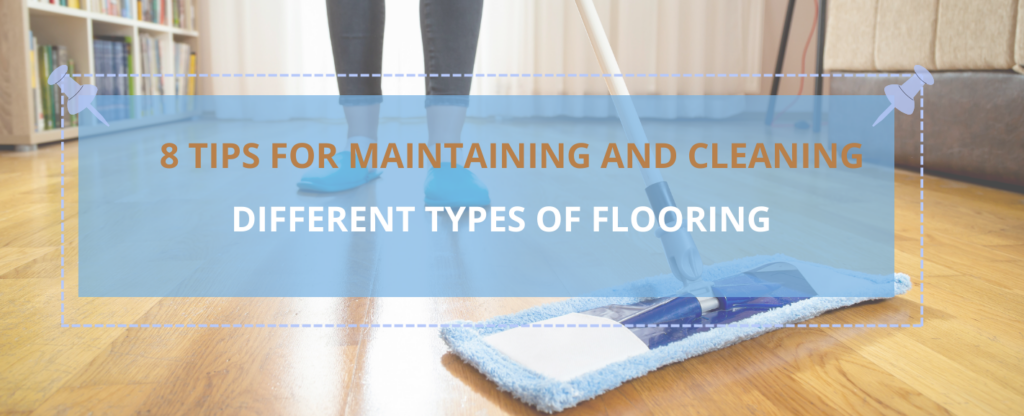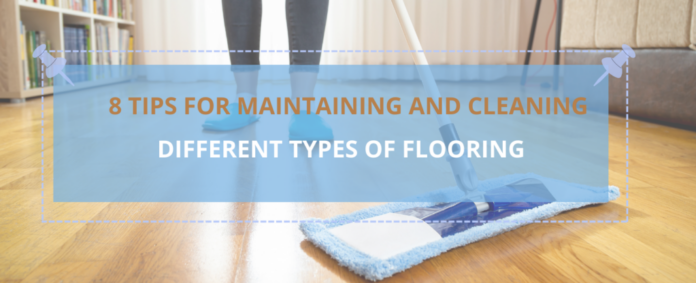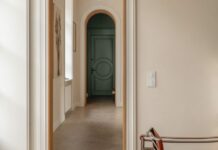
Floors are important for both the look and how usable a room is. Different floor types need different care to stay looking nice and last a long time.
This article will explain how to care for hardwood, laminate, tile, and carpeted floors so they will keep your home beautiful and save you money in the long run.
Floor Overview
Hardwood
Hardwood floors are both beautiful and durable, often providing a touch of elegance to your space. They come in different types (engineered hardwood and solid hardwood) in different colors and finishes.
But hardwood flooring is vulnerable to:
- Scratches and dents
- Moisture
- Discoloration from sunlight
- Requires regular sweeping and mopping with a damp cloth
Check out our other tips on how to care for hardwood flooring.
Laminate
Laminate flooring is a popular choice due to its affordability and a wide variety of styles that resemble natural materials.
Key characteristics of laminate floors are:
- Scratch and dent-resistant
- Less sensitive to moisture compared to hardwood
- Susceptible to water damage if left standing
- Easy to maintain, requiring only sweeping and occasional damp mopping
Luxury Vinyl Tile (LVT) and Luxury Vinyl Plank (LVP)
Vinyl flooring is versatile, budget-friendly, and comfortable underfoot.
Points to consider about vinyl floors:
- Water-resistant and suitable for damp areas
- Available in sheets, tiles, and planks
- Easy to clean with sweeping or vacuuming
- Avoid using abrasive cleaning materials or excessive water
Check out our other tips on how to care for luxury vinyl flooring.
Carpet
Carpet flooring provides warmth and comfort, in addition to muffling sound.
Factors to consider about carpets:
- Regular vacuuming helps maintain appearance and prolong lifespan
- Requires professional deep cleaning periodically
- Susceptible to stains and damage from moisture
- Different fiber materials require specific cleaning techniques
1. Clean Floors Based on Type
Hardwood Deep Clean
- Sweep or vacuum the floor to remove dust, dirt, and grit.
- Fill a bucket with a mixture of water and hardwood floor cleaner.
- Dampen a clean microfiber mop with the solution and wring out excess moisture.
- Mop the floor in the direction of the wood grain. Avoid using excessive liquid on the floor.
Carpet Deep Clean
- Vacuum the carpet thoroughly to remove dust, dirt, and debris.
- Pre-treat any stains with a carpet stain remover.
- Use a steam cleaner with a non-toxic carpet cleaning solution.
- After cleaning, open windows or use fans to help the carpet dry quickly.
Laminate Care and Maintenance
- Regularly sweep or vacuum the floor.
- Use a laminate floor cleaner; avoid using soap or water-based cleaners.
- With a damp microfiber mop, gently clean the laminate floor. Don’t allow liquid to pool on the surface.
Luxury Vinyl Tile (LVT) and Luxury Vinyl Plank (LVP) Floor Revitalization
- Sweep or vacuum to remove dust and dirt.
- Mix water and a mild detergent (avoid abrasive or ammonia-based cleaners).
- Use a damp mop to apply the solution to the floor, being careful not to soak it.
- Rinse with clean water and dry using a soft cloth.
2. Clean Your Floors Regularly
To keep your floors looking their best, establish a regular cleaning routine. Sweep, dry mop, or vacuum the floor daily to remove dirt, dust, and debris before it accumulates.
3. Deal with Spills Immediately
Accidents happen, but immediately addressing spills can help prevent stains and damage.
Here’s how to handle spills on different surfaces:
Spills on Hardwood Floors
- The faster you address the spill, the less likely it is to soak in and stain the wood. Grab a clean, absorbent cloth (microfiber cloths work well) and blot up as much of the liquid as possible. Work from the outside of the spill inwards to avoid spreading it further. Don’t scrub or rub, as this can damage the finish.
- Mix a solution of equal parts white vinegar and warm water. Dampen a clean microfiber cloth with this solution, wring it out well so it’s just barely damp, and wipe the affected area. Dry thoroughly with another clean, dry microfiber cloth.
- Scrape up any solids first. For the oily residue, you can try a mild dish soap solution. Mix a few drops of dish soap in warm water. Again, dampen your microfiber cloth with this solution, wring it out well, and wipe the spill. Rinse the area with a clean, damp cloth, and dry completely with another dry microfiber cloth.
- For best results, refer to the cleaning recommendations from your hardwood floor manufacturer. They might have specific cleaning products or solutions they recommend.
- Avoid using harsh chemicals like ammonia, bleach, or abrasive cleaners on your hardwood floors. These can damage the finish.
- If the spill leaves a stain, you might need to try a stronger cleaning solution. But be cautious. Test any cleaning product on an inconspicuous area of the floor first to make sure it doesn’t discolor the wood. Consider consulting a professional floor cleaner for stubborn stains.
- Place mats under potted plants and near doorways to catch drips. Or use area rugs in high-traffic areas to protect your floors.
Spills on Vinyl Floors
- Blot up as much of the liquid as possible without scrubbing, which can spread the spill.
- Avoid harsh chemicals like ammonia, abrasive cleaners, or wax-based products, as they can damage the LVT’s finish.
Here are some effective cleaning options:
- For everyday spills, mix a few drops of dish soap in a bucket of warm water. Dip your mop, wring it out well so it’s damp, not soaking, and mop the affected area. Rinse with clean water and dry thoroughly with a microfiber cloth.
- For a natural cleaning option, mix one cup of white vinegar with a gallon of warm water. Following the same method as the dish soap solution, mop the spill, rinse, and dry.
- For greasy or stubborn food stains, create a paste of baking soda and water. Apply the paste to the stain, leave it for a few minutes, then gently scrub with a soft brush. Wipe clean with a damp cloth and dry thoroughly.
- If you’re unsure about a particular stain remover or have a high-end LVT, consult your floor manufacturer’s cleaning recommendations. They might have specific products they recommend.
Additional Tips
- Always test any cleaning solution on an unnoticeable area of the floor first to ensure it doesn’t discolor the vinyl.
- Avoid using excessive water, as LVT can be susceptible to moisture damage underneath.
- For regular cleaning, sweep or vacuum your LVT/LVP floor with a soft brush attachment to remove loose dirt and debris that can scratch the surface.
Spills on Laminate Floors
Laminate flooring requires a specific cleaning approach to avoid damaging its delicate surface.
- Grab a clean, absorbent cloth (microfiber cloths are ideal) and blot up as much of the liquid as possible. Work from the outside of the spill inwards to prevent spreading. Don’t scrub or rub, as this can scratch the laminate.
- Mix a gallon of lukewarm water with a cup of white vinegar and a few drops of dish soap in a bucket. Wring out a microfiber mop thoroughly so it’s barely damp, not soaking. Mop the spill area, then follow with clean water to rinse and dry completely with another microfiber cloth.
- Consider using a store-bought laminate floor cleaner specifically formulated for this type of surface. Always follow the product’s dilution and application instructions carefully.
- Never use ammonia, bleach, oil-based soaps, or abrasive cleaners on laminate flooring. These can damage the finish and even cause warping.
- For sticky messes or marker stains, dampen a clean cloth with a small amount of rubbing alcohol. Test first! Gently wipe the stain, then follow with a damp mop and thorough drying.
- Oil-based stains like paint might require acetone (nail polish remover). Be extremely cautious! Test in a hidden spot first. Apply a tiny amount to a clean cloth and dab at the stain, then immediately follow with a damp mop and thorough drying. Important note: Due to the harshness of acetone, it should only be used as a last resort and only in very small areas.
Spills on Carpet
- Blot up as much of the liquid as possible with a clean, absorbent cloth or paper towel. Work from the outside of the spill inwards to prevent spreading. Don’t rub, as this can push the spill deeper into the carpet fibers.
- For tougher stains, consider using a store-bought carpet cleaner. Always test the cleaner on an inconspicuous area of the carpet first to make sure it doesn’t discolor the fibers. Follow the instructions on the cleaning product label.
- After using a cleaning solution, you may want to rinse the area with a white vinegar and water solution (one part vinegar to two parts water). This will help neutralize any cleaning residue. Blot the area dry with a clean cloth.
- Allow the carpet to air-dry completely. You can place a fan in the area to speed up the process. Avoid using direct heat, as this can damage the carpet fibers
Knowing what you spilled will help you choose the right cleaning method. Common spills include:
- Water-based spills (coffee, juice, soda): Mix a solution of one tablespoon of dish soap with two cups of warm water. Blot the spill with a clean cloth dampened with this solution. Rinse the area with a clean, damp cloth and blot dry with a fresh towel.
- Oil-based spills (grease, cooking oil): Scrape up any solids first. Sprinkle baking soda on the spill to absorb the oil. Let it sit for 30 minutes, then vacuum it up. You can then follow up with a gentle dish soap solution, as mentioned above.
4. Do Some Protective Measures
To prolong the life of your flooring, implement these protective measures:
- Place entrance mats near doors to catch dirt and moisture.
- Use furniture pads to prevent scratches from heavy furniture.
- Limit exposure to direct sunlight by using curtains or blinds.
- Regularly trim pet nails to reduce the risk of scratches.
These basic maintenance tips will help keep your floors looking great for years to come.
5. Add Entryway Barriers
These barriers prevent dirt, debris, and moisture from being tracked onto your floor.
To set up an effective barrier system:
- Place a durable outdoor mat outside the entrance to remove large debris.
- Add an absorbent indoor mat to catch any remaining dirt, moisture, and fine particles.
- Use a shoe rack or designated area for shoes to prevent walking on the floor with dirty footwear.
6. Use Furniture Pads
When furniture moves or scrapes across the floor, it can cause scratches, indentations, and other damage.
Use furniture pads or protective covers on the legs and bases of your furniture.
Remember to:
- Choose pads made from felt, rubber, or similar material to avoid damage and provide good grip.
- Regularly inspect and replace the pads as they wear out over time.
- Refrain from sliding or dragging furniture, even with pads, to minimize the risk of floor damage.
Climate Considerations
Different types of flooring respond to changes in temperature and humidity in different ways.
To protect your floors from environmental damage:
- Monitor and control the humidity levels to prevent warping, buckling, or excessive expansion and contraction.
- Use a dehumidifier or humidifier if necessary to maintain a stable environment, especially in areas with extreme climate fluctuations.
- Protect your flooring from direct sunlight by using curtains, blinds, or UV-resistant window film to prevent fading or discoloration.
By taking these preventive care measures, you can maintain the quality and beauty of your flooring for years to come.
7. Hire a Professional Cleaning Service
When to Hire a Professional
Even with regular maintenance, there are times when a professional cleaning service is necessary.
Consider hiring professionals in these situations:
- Deep cleaning: At least once a year, your flooring needs more than just everyday care. A professional deep clean can remove stubborn dirt, debris, or stains.
- Difficult stains: If you have tried DIY methods to remove tough stains without success, a professional can use specialized equipment and solutions to address the issue.
- Restoration: Older or damaged flooring may require a professional to restore it to its original condition. They have the tools and experience to handle delicate materials.
- Moving in or out: When moving into a new place or preparing one for resale, a professional cleaning service can ensure that the floors are in their best condition.
Choosing the Right Service
When looking for a professional cleaning service, keep these tips in mind:
- Research: Start by asking friends, family, and online reviews for recommendations.
- Compare services: Different companies offer various cleaning methods, such as steam cleaning, dry cleaning, or encapsulation. Research which method suits your floor type best.
- Check certifications and experience: Look for professionals with industry certifications and a proven track record.
- Request a quote: Contact at least three different companies, provide information about your floor type, condition, and area, and ask for a written quote.
- Inquire about guarantees: A good service provider should provide a satisfaction guarantee.
8. Schedule a Deep Clean
Scheduling a regular deep cleaning for your floors can help maintain their appearance and prolong their lifespan.
Depending on the type of flooring, different cleaning methods and products will be necessary.
Below is a table with recommended deep cleaning schedules for various flooring types:
| Flooring Type | Deep Cleaning Frequency |
|---|---|
| Tile and Stone | Every 12-18months |
| Vinyl | Every 18-24months |
| Linoleum | Every 12-18months |
| Hardwood | Every 3-5years |
Effortless Elegance: Maintaining the Beauty of Your Floors
Keep up with your regular cleaning routine and observe your floor’s condition to determine if you need to deep clean more frequently. A well-maintained floor can make a significant difference in the appearance and functionality of your space.
Learn more about taking care of your floor with 50Floor. Check out more on how to clean and maintain your floors with our floor care guide.
Besides helping homeowners take care of their homes, we also offer different floors to suit any space. Choose from a wide array of hardwood floors, carpet floors, laminate flooring, and vinyl planks and tiles. Call us at (1-877-503-5667) to get started!

The post 8 Tips for Maintaining and Cleaning Different Types of Flooring appeared first on 50Floor.
50floor.com










